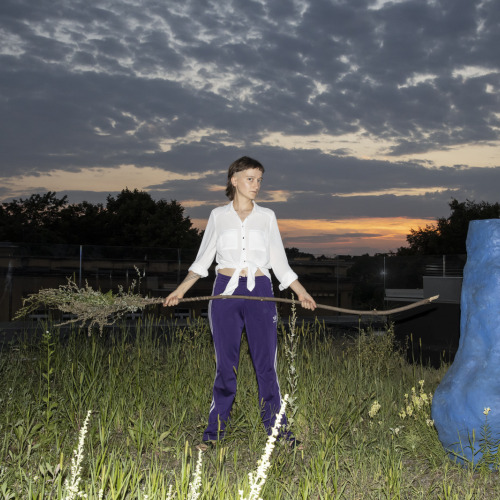
A Room of One’s Own
City of Women presents in Galerija Anonimus three rooms arranged by three contemporary artists. In “Eclips” Anne-Mie Van Kerckhoven invites us in her androgynous “interior with video”. The virtual rooms of Julia Scher and Jenny Holzer are public spaces located (assuming one can still use this terminology) in the research and development laboratory äda’web. Surveillance artist Julia Scher offers us a “safe-haven” in her “Securityland”. Jenny Holzer’s “Please Change Beliefs” exposes the instability of beliefs on the constantly mutating info-bahn.
Annie-Mie Van Kerckhoven
Annie-Mie Van Kerckhoven (b. 1951, Antwerp) lives and works in Antwerp, Belgium.
From 1975 she started exhibiting her drawings, paintings, and later (multi-media) installations. In 1981, with Danny Devos, she founded the Club Moral, an artists’ initiative intended to present “extreme art in the field of performance, installation, and music”. Currently she teaches at the Royal Academy of Fine Arts in Ghent and is a permanent guest-lecturer at the Rijksakademie in Amsterdam. Her work has been shown extensively all over Europe, in the USA, Australia, and in Hong Kong.
“AMVK’s interest lies in the alchemy of reality: not what it is, but what forces underly it (...) AMVK breaks open and binds. She shows the fetishism of our consciousness. The alliances AMVK describes never find once-and-for-all expression: the real reality is protean, ever-changing, shape-shifting. (...) (her) work displays a demiurgic will to total awareness; in her protest it takes on the repressive traits of the structures it aims to break down. (...) In contrast to the organisation of the world, her work attempts an anti-brainwash. A blunt choice, certainly in an art context in which an indirect approach is often taken, in which irony speaks from the corner of its mouth (...) She chooses protest - outside the context of protest. (...) With the face of the pantocrator, she steers our consciousness off the rails, outside itself.” (Dirk Pueltau)
äda’web
The World Wide Web is an environment where the boundary between map and territory collapses. It is a system of representation as much as it is a realm, which in itself can be understood as a representation. The usual dichotomies such as real/unreal, true/false, etcetera, seem to be especially irrelevant in this realm. Location as a means of originating material also appears to be inapplicable to web documents and projects. These may be housed in a multitude of servers, and then again, “mirrored” (duplicated in another location): accessing a page that is housed on a given server may call for elements (images, sounds, text, video) that are housed elsewhere, and a similar page may be accessed on another server. As a result, the notion of origin is no longer applicable to identifying information. This may serve as a useful metaphor: the notion of tracing cultural fragments in order to understand them within a linear progression can no longer apply; “multi-culturalism” is the new context within which those fragments need to be associated and comprehended. (...) äda’web was started in the fall of 1994, when the World Wide Web started to emerge as a mainstream medium. (...) It is a web station which aims at providing artists with the means and context to develop medium-specific work, to explore and enhance the potential of digital media; it is a research and development platform, in that it participates in defining the parameters of the World Wide Web as a new means of information flow and exchange.
(excerpts of “äda’web” in the catalogue of “Interzones”: Kunstforeningen Koebnhavn & Uppsala Konstmuseum, curators: Octavio Zaya & Anders Michelsen; Courtesy Benjamin Weil)
Jenny Holzer
The main focus of Jenny Holzer has been on the investigation of the means to disseminate her ideas within public spaces. Since the late seventies, she has been working on the street and in public buildings, using media that would enable her work to blend in the landscape. From LCD displays to posters and stickers (applied to such urban elements as telephone booths or parking meters), the texts function as comments on the environment they fit into, stimulating awareness of our social conditioning as conveyed by the very landscape in which we may be confronted by them. The work of Jenny Holzer has been shown worldwide in prominent institutions such as the Guggenheim Museum (New York), the American pavi-lion at the Venice Biennale (Italy), the Institute of Contemporary Art London (England) or the Centre Pompidou (Paris). “Please Change Beliefs” is Holzer’s first project on the World Wide Web, and is developed in the same spirit as her previous experiments in the public sphere.
(Courtesy äda’web)
Julia Scher
Julia Scher was born in 1954 in Hollywood, California. She lives and works in Boston. Julia Scher is represented by the Andrea Rosen Gallery, NYC. Her work, which focuses on surveillance and the cyber-sphere, has been shown extensively in the United States and Europe.
Scher reminds us of the fact that we are often unaware of the dangers constituted by the increasingly omnipresent surveillance systems, constantly monitoring us in the public space and - since short also - in our private rooms. “Scher is one of a number of emerging artists who deliberately misuse technology to expose its hidden ideological mechanisms. Demonstrating our complicity in the proliferating technologies used to surveil both our physical and virtual identities, she toys with the notion of scopophilia, the cheap, reflexive thrill of looking. (...) With its infinite links to packets of (potentially “dirty”) data and its decentralized, labyrinthine design, the World Wide Web is an ideal medium for Scher. Indeed it might almost have been created by Scher herself, in her ongoing search for increasingly use-friendly surveillance systems that attract as they track.”
(Andrew Hultkrans)
Sponsors: Marand, Telekom, Vodeb Supported by: Soros Center for Contemporary Arts Ljubljana;
In collaboration with: Galerija Anonimus, äda’web, argos

